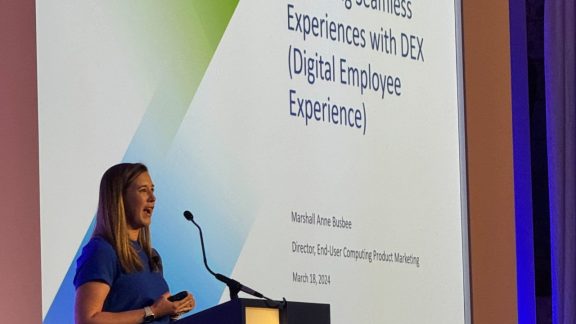There's a lot of buzz and speculation these days around client hypervisors. VMware demoed some cool stuff last year at VMworld; our own Desktop CTO Scott Davis blogged on this topic back in January, (http://blogs.vmware.com/view-point/2010/01/vmware-view-and-thick-clients.html); of course there were noteworthy announcements this past week at a certain trade show. Now that formal product announcements are starting to appear, it's time to cut though the speculation and get down to brass tacks of the business value this year's offerings are likely bring.
Bottom line: VMware will deliver a View based solution that directly addresses Bring Your Own Computer, and similar usage models. This is not a hyped-up personal/corporate compromise solution, but a solution that addresses many real issues faced today.
So what usage models are we talking about? There's a lot of acronyms thrown around: Bring Your Own Computer (BYOC), Bring Your Own PC (BYOPC), Employee Owned IT (EOIT); I even like to throw in the term Contractor Owned IT (COIT). It all boils down to someone working on client hardware that is not physically owned and managed by corporate IT. Usage models range from the highly strategic to common sense tactical.
Strategic might include empowering employees to choose their hardware from the local electronics store. I talked with one Fortune 500 customer with a BYOC initiative driven from their HR department: too many talented employees were quitting and making clear in their exit interviews that they were fed up with inadequate hardware. Said hardware was a joke compared to the personal laptop they carried around in their messenger bags every day. Another example is the distributed and mobile workforce. Here, it's painful to keep users' devices in good working order: if a machine breaks, it's better for the business if the employee can go to the local big-box store and be up and running with a new machine in minutes. The traditional alternative is a multi-week wait for a new IT owned device: get the PR processed and ordered from the OEM; ship it to corporate HQ for inventory and imaging; finally re-ship it to the employee's home office; better hope the employee isn't on the road at the time. The push to address these sorts of scenarios with off the shelf hardware will only increase as those who have grown up with modern personal computing grow proportionally in the workforce, and the "consumerization of IT" moves forward.
On a more tactical front, you have simple dollars and cents around additional devices. If a contractor or offshore employee comes equipped with hardware supplied by their own organization, why not leverage those physical resources to get work done? I talk with customers today who must purchase and provision new machines for contractors simply to ensure those individuals have access to the corporate desktop environment. That's a scenario a proper BYOC solution should address.
Right now, both VMware and our competitors have a variety of solutions for these use cases as long as said users are reliably connected to the corporate network. We know that isn't always realistic. Sometimes you've just gotta get work done without that robust network connection.
Enter View Client with Local Mode.
Unlike what others are pushing with much hyped "Type-1" client hypervisors, View Client with Local mode installs cleanly and non-destructively on an existing Windows Laptop or PC. You don't need to start with brand-new hardware from an OEM. You don't need to wipe out or destructively modify an existing OS installation and void your service/support contracts. It's "just software" that solves real problems.
Once View Client with Local Mode is in place, you'll be able to do things like…
As an end user:
- Checkout a desktop from the datacenter to run on the client device regardless of network connectivity.
- Enjoy a full fidelity desktop experience with 3D DirectX9c support, Aeroglass effects on Win7, support for devices like web-cams and VOIP.
- Immediately get access to a replica desktop if the client device (e.g. laptop) fails or is lost.
- Get a real choice of client devices.
As an administrator:
- Manage and monitor Local Mode desktops centrally from the same View administrative console and VM images as the rest of a VMware View deployment.
- Maintain control over end user desktops – revoking privileges and pulling data back to the datacenter on demand.
- Know corporate data is secure from outside attack with AES 128 or 256-bit encryption.
- Reduce overall CAPEX costs, both on newly purchased client devices, and lower upfront datacenter investment.
- Leverage an existing hardware fleet to deploy Local Mode desktops.
- Cleanly separate the Windows update/refresh cycle from hardware update/refresh cycles.
To visualize all this, below you see a managed Windows XP desktop running Google Earth with 3D buildings enabled (using DirectX) on top of an unmanaged Windows 7 laptop:
View Client with Local Mode will flexibly deliver real value for desktop workloads across a variety of BYOC use cases including offline, EOIT and COIT. Feel free to drop by the VMware booth at any upcoming tradeshow or visit the VMware Express Truck (http://info.vmware.com/content/VMwareExpress) to see View Client with Local Mode in action.






